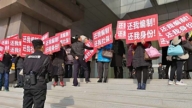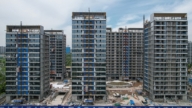【新唐人2012年7月31日讯】近来中国很不太平。北京暴雨,扬州地震,就连一向民风和谐的江苏南通启东市也爆发数万民众上街,抗议日资造纸厂排污口工程风波,场面火爆。“王子造纸公司”周一发表声明,否认排污工程将污染当地水源的说法。与此同时,有消息传来,厂内污水自去年起已经排入长江,而首当其冲受影响的是:四千万上海市人的食水。消息引发上海等地网民震怒,并呼吁发起类似启东的抗争行动。
7月30号,“王子造纸”发表声明表示,有关污水中含有致癌物质的说法是“毫无根据的”。声明说,污水在排出前已经经过净化处理,绝对符合中国标准。
上周末,数以万计的江苏启东市民爆发大规模示威,并冲进市政府,反对日资厂排污。
28号下午,当局调来2万名军警,镇压抗议民众。有人权组织指称,事件已造成3人死亡,多人受伤,超过100人被捕。
面对官民激烈冲突,南通市政府当天决定永久取消“南通排海工程”。但有关工厂今后产生的污水将如何排放,当地政府与“王子造纸”并没有做出说明。而据《日本共同社》报导,“王子造纸”29号已经复工。
不少民众对此表示质疑和担忧。
大批网民在微博转载日本《朝日威廉希尔体育官网》的报导说,造纸厂早于去年(2011年)1月投产时,已将污水排入长江,并且说污染或许已遍及长三角地区。
有网民制作地图显示,位于南通经济开发区的“王子造纸”,排放的污水若经长江流向下游,首当其冲的将是为上海市内四千万人口提供食水的“青草沙水库”。
“达尔问自然大学水学院”负责人邵文杰认为,现在急需弄清楚,“王子造纸”排污口的水质有没有达到规定的标准。
“达尔问自然大学水学院”负责人邵文杰:“假如说它排污管道的排污口的水质是达标的,它对长江的影响也是非常非常大的。因为从长江整个的情况来看,下游的水质越来越差,污染企业又特别多,影响特别重,要不然它为什么要把那个管道伸入海洋里面去?”
消息引发长江下游上海等地网民哄动,除有民众狠批政府卖国、“治标不治本”等等,更有网友呼吁沿江民众发起类似启东的抗争行动,网友说:“我们要取消这个项目,不是让你换个地方排!”
中国政治和社会观察家戴晴指出,中国经济所谓的快速发展,主要以两个方面为代价。
中国政治和社会观察家戴晴:“一个是完全没有权利的平民,第二个是完全没有权利的环境和资源。所以看起来有表面的繁荣在发展,可实际上伤害的是平民百姓和资源和环境。那么现在我觉得特别好的,就是像四川的甚邡和很多地方,普通的百姓,他们已经起来,自己起来知道保护自己的土地了。终于中国人民觉醒了,有了‘自己是有权利的’意识。这个比什么都好。”
戴晴说,普通百姓的土地和生活条件完全被毁坏之后,他们就会变成无家可归,他们就处于绝境。
上海市民:“作为中国老百姓,我感到非常的不庆幸。即使它不排放,我们喝的水也不干净。我吃的菜不干净,我吃的米饭还有激素。这个是我们执政党的问题,体制的问题,体制不破,永远得不到有效解决。”
日本“王子造纸公司”自2007年起开始在中国建设工厂,工厂每天排放的污水量将达到15万吨。
因此,有网友说,现在“王子造纸”只建完第一期项目,还有第二期和第三期,等到全部建成之后,势必将有巨量的污水直接排入长江,上海人民就等着喝工业废水吧。
采访/朱智善 编辑/王子琦 后制/朱娣
Water Pollution in Qidong Threatens Shanghai
China has not been peaceful recently, with rainstorms
in Beijing, the earthquake in Yangzhou,
and Qidong’s protest against a polluting paper mill,
which has involved tens of thousands of citizens.
On July 30, the Oji Paper Company denied suggestions
that local water pollution was caused by its plant in Qidong.
A news report, circulated on the internet, alleged
that the plant’s drain water has been discharged into the Yangtze River since 2011.
Drinking water for 40 million Shanghai
residents’ would be firstly affected.
The news has greatly shocked netizens
in Shanghai and nearby areas.
They appealed to follow Qidong’s mass protest.
On July 30, Oji Paper publicly stated that
the talk is “groundless” about carcinogenic sewage.
The discharged sewage has been purified and absolutely
meets Chinese standards, the announcement claimed.
Last weekend, tens of thousands of Qidong citizens
took to the street to protest the polluting industrial project.
They occupied the government office building.
On July 28, over 20,000 police entered Qidong.
The suppression has killed three people and wounded
many, a human rights organization alleged.
Over 100 protesters were reportedly arrested.
Under strong pressure, Nantong CCP authorities announced
it would permanently suspend the polluting project.
But no explanation was given by the authorities
and Oji Paper on how to discharge sewage.
On July 29, the production of the Oji Paper plant in Qidong
was resumed, according to Japan’s Kyodo News reports.
It has aroused wide public doubts and concerns.
A news report in Japan’s Asahi Shimbun
has been widely reproduced in micro-blogs.
It said that back in January 2011, the paper mill’s
sewage was discharged into the Yangtze River.
The news reported that contamination might
have spread all over the Yangtze River Delta region.
A map drawn by a netizen shows that the Oji Paper factory
is located in Nantong Economic Development Zone.
If the discharged sewage flows downstream
in the Yangtze River, a reservoir would be effected first.
This reservoir provides drinking water
for 40 million Shanghai residents.
Shao Wenjie, Director for Water Education learning
Society noted that
the most urgent thing now is to find out whether the
factory’s drainage water reaches required quality criteria.
Shao Wenjie: “If the drain water doesn’t meet quality
standards, it would have great impact on the Yangtze River.
Its downstream water quality is now getting worse.
A particularly large number of polluting
factories have been set up in the area.
If it isn’t polluting, why didn’t it lay
its sewage pipeline into the ocean?”
The news has aroused great concern among
netizens in the lower area of the Yangtze river.
Some posts criticized the CCP regime’s irresponsibility.
Some called on residents to protest like Qidong citizens.
“We need to cancel this project rather than allow
it to change the area into a sewage discharge!"
Dai Qing, a China observer, comments that the rapid growth
of China came at a cost of two major factors.
Dai Qing: “The first is the populace is stripped of civil rights.
The second is the devastating use of environmental
resources. China’s prosperity is on the surface.
It is based on the sacrifice of civilians,
resources and the environment.
Now I feel particularly good, as lots of ordinary people
in many places like Shifang in Sichuang have stood up.
They acted to protect their environment.
The Chinese people are awakening at last.
They’ve come to understand that ‘we have our own rights’,
which is the best awareness.”
Dai Qing said that ruining the land and living conditions
make ordinary people homeless and hopeless.
Shanghai citizen: “I feel very unlucky to be Chinese.
Even without being affected by sewage, we’re still drinking
unclean water and eating polluted vegetables.
Even the rice I eat contains hormones.
That was caused by the ruling party; the political system.
Without disintegration of this system,
the problem will never be resolved.”
Japan’s Oji Paper Company started
construction of its plant in China in 2007.
The plant’s sewage discharge will
reportedly reach 150,000 tonnes daily.
A netizen posted on the internet that Oji Paper
has just finished the first phase of it’s projects.
Phase II and Phase III have been on the agenda.
When fully operational, the factory will pour huge
amounts of sewage into the Yangtze River.
Then the Shanghai residents will have no other
choice but to drink industrial wastewater.




























